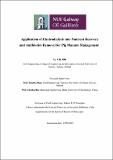| dc.description.abstract | Animal manure should be regarded as a resource rather than a waste as it contains abundant nutrients (nitrogen and phosphorus) available for plants. Land spreading of animal manure is a common practice while it has to be limited not exceeding the land carrying capacity. Nutrient recovery from excess animal manure, either in the form of raw manure or anaerobic digestate, is important and necessary for the sustainable development of animal farming. Since animal manure is a reservoir of veterinary antibiotics, the biosafety regarding antibiotics during nutrient recovery should be taken into account.
In this Ph.D. research, the application of electrodialysis (ED) technologies to recover the nutrients from pig manure was assessed. The research objectives were to: (1) assess the feasibility of nutrient recovery from pig manure digestate using electrodialysis reversal (EDR); (2) assess the recovery of nutrients and volatile fatty acids (VFAs) from pig manure hydrolysate using bipolar membrane electrodialysis (BMED); (3) investigate the fate of antibiotics in relation to membrane fouling in an EDR process for nutrient recovery; and (4) investigate in-situ anodic oxidation in EDR for antibiotics removal and fouling mitigation.
The results showed that the EDR removed all ammonium nitrogen (NH4+-N) and 84% of phosphorus (PO43–-P) from the feed solution. Particle and chemical fouling were mitigated through the reversal of electrodes during EDR. Organic matter was the main cause of membrane fouling, while this fouling levelled off gradually, indicating the potential of long-term operation of EDR for nutrient recovery.
Bipolar membrane electrodialysis was able to separate NH4+-N into the base product and PO43–-P and VFAs into the acid product. It was observed that there was a diffusion of ions through the bipolar membranes, causing the low recovery of NH4+-N and impurity of products. A BMED model was established to quantify the ion flux balance and a novel two-stage BMED was developed based on the ‘inflection point’ of the voltage profile. The research results proved that this two-stage BMED can efficiently improve the product yield and purities.
Antibiotics can be concentrated in the product solution during nutrient recovery, causing the risk to the people, animals, and ecology when using the product as fertilizer. Using synthetic wastewater, it was found that 90% of the sulfadiazine (SD) and tetracycline (TC) in EDR were removed from the feed solution due to membrane sorption, and transported to the product solution and membrane matrices. SD can pass through the membranes, while TC accumulated in the membrane-solution interface, showing an association with particle and organic fouling. Comparing with the synthetic wastewater, lower removal efficiencies of SD and TC were observed due to the membrane fouling when treating real pig manure.
The anode in ED was utilized in-situ for the oxidation of antibiotics, fouling mitigation, and pathogen inactivation. Anodic oxidation had negligible effects on the Cl–, NH4+-N, and PO43–-P, but rapidly removed the SD and TC from the feed solution. The particle fouling was significantly mitigated due to gas bubbling, and E. coli and Enterococcus were efficiently inactivated in the initial 30 minutes. Despite a high generation potential of disinfection by-products (DBPs), trihalomethanes and haloacetic acids in the feed solution were only 134 and 192 μg/L, respectively, proving that the effluent (feed solution) generated is far safe for water reclamation.
The results in this research indicate that EDR and BMED are efficient in nutrient recovery from pig manure. In-situ anodic oxidation in ED reactors can remove antibiotics, mitigate fouling, and inactivate pathogens, with low concentrations of DBPs produced. The data obtained will provide with alternatives for pig manure management regarding nutrient recovery and biosafety. | en_IE |


